
This week we’re delivering an extended stay with the Moto X, a device presented by Motorola as the current sweet spot in the center of price, usability, and customizability. This device marks a point in the history of Android where what my colleague Chris Davies calls a “Context Ecosystem” has dawned, and in it an essential dismissal of winner-take-all hardware specifications in favor of an overall best-in-class user experience.
Hardware
Though the Moto X isn’t a machine that attempts to take the top tier spot from its competitors in a hardware race, Motorola has presented a solution that’s certainly better than the vast majority of the mid-tier this year. That said, when it comes down to it, there’s not many people out there (beyond device reviewers such as your humble narrator here) that have the Moto X in one pocket and the HTC One in the other.
Out in the wild, the Moto X is just as impressive looking a device as the Samsung Galaxy S 4.
Bringing it in to the lab for a full review bench analyzation, on the other hand, you’ve got a smartphone that’s just good enough (by the numbers, anyway). Moto X works with a 65.3 x 129.3 x 5.6-10.4 mm body weighing in at 130 grams. This device has a 4.7-inch display working with 720 x 1280 pixels, that ringing in at a cool 312 PPI.

Under the glass is a localized haptic feedback system. This means that wherever your finger is located on the display – if you’ve got haptic feedback activated – you’ll feel buzzing as if it were, indeed, right under your fingertip.
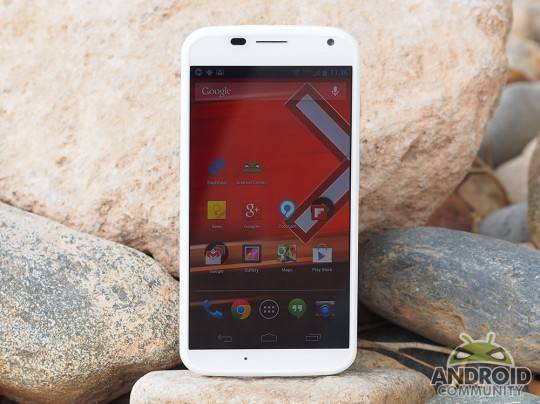
This display is covered with a pane of Corning Gorilla Glass and sits atop a Motorola X8 computing system. That’s a 28nm dual-core Qualcomm Snapdragon S4 Pro (MSM8960), a “contextual computing processor”, and a “natural language processor” besides. As you’ll see in the benchmark collection later in this review, this doesn’t key in as the most powerful bit or processing architecture on the planet – but in real-world use, it’s exceedingly smooth and swift.

Moto X has a bit of a wave to it up its back – this cover is not removable, but it does represent one half of the customization suite presented in Moto Maker. With Moto Maker you’re going to be able to choose the front border (white or black) as well as the backside (in a variety of colors) depending on what’s available when you order. At the moment – if you include accent colors – Moto X is set to launch with a total of 252 different color combinations.
We’ll save jumping in deep on customizability for now due to the fact that the machine we’re reviewing here is the Verizon version of the Moto X. The Verizon 4G LTE iteration of the Moto X is only set to be available in white or black, while, for example, the AT&T edition is fully customizable and custom-order-able.
UPDATE: Motorola notes that the Moto Maker option for custom-coloring Moto X will eventually roll out to iterations of the device beyond AT&T. Have a peek whenever you’re reading this review to see what’s up now!
This mirrors similar availabilities of smartphones with Verizon, but will still one-up the HTC One, which will almost certainly be available in only one tone at launch (with this carrier, that is). In all, the Moto X is currently scheduled to arrive in the USA with Verizon, T-Mobile, Sprint, AT&T, and US Cellular.

Moto X is assembled in the USA. Motorola and Google have been keen to remind the public that the 4-day order-to-doorstep time of the custom-colored Moto X is due to the machine being put together in Fort Worth, Texas. This team of “around 2,000” are also putting together the rest of the carrier iterations of the device as well – including Verizon’s, from what we understand – even without the customization features.
This device works with a nano-SIM tray, the first of its kind outside the release of the iPhone 5. You’ll be able to grab nano-SIM cards from whatever carrier you’re all about soon, otherwise a simple SIM-cutter with the right size about it can kick out what you need using the SIM card you’ve got on hand. That’s not the sort of thing your carrier will recommend, as it’s not the safest thing in the world to be doing if you’re not sure of hand, but if you’re brave, have at it.
The bottom of this smartphone holds a standard microUSB port (without MHL, mind you). There’s also a lack of a microSD card slot, and the 16GB iteration of the machine – which we’re using here – works with 11.88GB of internal storage out of the box.
Software
Motorola’s choice of an AMOLED display opens up a door several other devices have aimed for here in 2013: selective display activation. This means that the display doesn’t need to light up completely to show an image. Individual pixels can light up on their own, this allowing the notifications system included in Moto X to keep power consumption down to a minimum.
When a new notification comes in, swiping up opens it up and swiping down dismisses it. A preview of the content within guides the user – you – in what you’re going to want to do with said notification.
Inside you’ve got what at first may appear to be a pure version of Android. Instead you’re working with Verizon (or whatever carrier you’re with) apps like VZ Navigator, My Verizon Mobile, Verizon Tones, and NFL Mobile. This is also an iteration of Android that’s not set to roll out aside Google’s Nexus lineup. Instead you’re working with Android 4.2.2 Jelly Bean while the Nexus line (at the time of this review’s first publication) is working with Android 4.3.
Motorola has also added a collection of apps to run alongside Google’s standard fare. One of these apps is Motorola Assist. This system is broken up into use modes, each of these detected by a variety of sensors embedded within this machine’s hardware.
One example is Driving mode – Moto X uses GPS and accelerometer information to see that you’re moving rather quickly. If you’re moving at a speed that’s obviously faster than you’re able to run, Driving mode gives you he option of speaking text messages aloud and send incoming calls to speakerphone.
As you may have already guessed, Google Now is always listening.
Moto X uses Google Now much in the same way that Google Glass does, working with Qualcomm’s architecture inside to allow for a low-power mic system that can indeed stay active without draining your battery swiftly, listening for your voice throughout the day. The option to turn this feature off or on is, of course, always ready to be toggled.
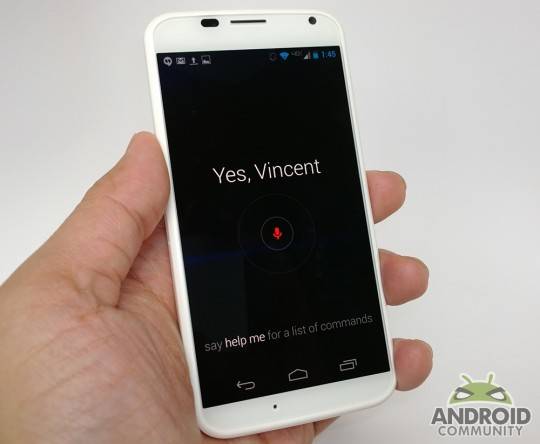
In our tests we’ve found the system to deliver results even so far as 5 feet away – with a clear line of sound, of course. The system is able to learn your voice with a simple process that includes saying “OK Google Now” a total of three times. A similar system is being built-in to Google Now for all Android devices right this minute – without the always-on listening in general, but in some cases coming with the who shebang.
Bluetooth controls are advanced in Moto X to a point where you’re able to have the machine skip PIN connections when it recognizes a device. This means that you’ll be able to connect to a device in your home, leave home, connect to a different device, and once you enter your home (within a 100 meter range unless you’re in Blueooth LE mode which is a 50 meter range), you’ll be automatically re-connected without having to press OK.
Performance
With the Motorola X8 computing system mentioned earlier in this review, the Moto X is every bit the 2013 contender for high-powered instant-reaction software machine that the other top-tier smartphones on the market present. Even with Qualcomm’s dualcore 1.7GHz Snapdragon S4 Pro and Adreno 320 quadcore GPU onboard, the Moto X won’t necessarily be kicking butt in the war for most hardcore processing beast.
What you’re seeing above is a collection of tests run on the Moto X aiming at giving a really, really basic idea of how hard it can beat up said tests. These tests, as always, should be taken with a side-eye toward applicability. In the end, it’s only two devices with the exact same build save the processor that these tests can truly hope to accurately test against one another.
Camera
It’s in the back-facing camera on the Moto X that Motorola appears to have held nothing back – it would appear that there’s just no explaining away the need for a top-tier camera experience, even when the rest of the device isn’t aiming to beat the competition down with higher numbers. What you’ve got here is a 10.1-megapixel Clear Pixel sensor and a single LED flash.
Motorola notes that a brand new “RGBC” red-green-blue-clear CMOS works with an f/2.4 aperture to bring on 75-percent light sensitivity. This setup does not work with OIS (optical image stabilization), which – if you’re depending on such things – could be a bit of a downer, but from what we’ve experienced thus far, it’s not something we’d cry over.
Inside the app you’ll find a collection of the basics. There’s HDR modes, panorama, and tap-to-focus can be found on toggle, while the most unique features are found right at the surface. One of these is the ability to take a massive amount of quick-fire photos by holding one’s finger down on the camera’s viewfinder.
Another is the highly efficient quick-launch of camera app itself which Motorola gives the option of launching with a quick flick of the device itself. Have a peek at the video above to see how this camera experience pans out in some real-world usage.

Below you’ll see a collection of photos and video filmed and shot with Moto X in a variety of environments. Have a peek at how they turn out both in the bright sunlight and in the dark of night in New York City.
ABOVE: 1080p video inside a tram. BELOW: 1080p video at night and in slow motion.
Battery Life
Motorola has made it clear that in optimizing the Moto X with its Motorola X8 processing architecture (with Qualcomm in tow), they’re aiming for 24 hours of “mixed usage.” This could mean anything, of course, and we’ve found that it’s not quite so cut and dry when it comes to how much you can actually use the smartphone if you want to achieve said amount of hours.
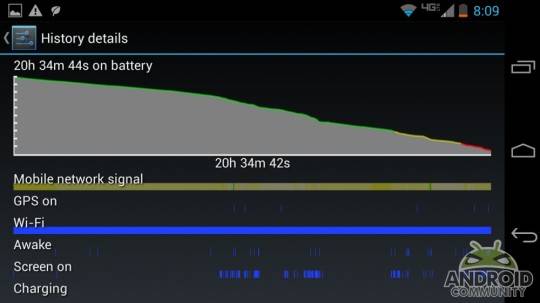
As close as we’ve gotten thus far is a right-around 21-hour span, most of which was spent with the device asleep. This is after a 3-hour charge the night before, bringing the device up to 100% battery, and 8-hours on the nightstand (which you’ll see in the first section of this battery read-out screen.) We’ll be doing additional battery tests in the near future. For now, don’t expect your first 24 hours on the Moto X to be without at least one charge near the end.
Wrap-up
The current price on the Moto X – for those companies still working with 2-year contracts – is $199.99 (with a 2-year service contract signed, of course). That’s a price that makes the device worth the cash if you’re not comparing it directly to the rest of the smartphones on any one carrier. If you’re not the sort of person who likes to modify their phone’s software and gain access to the features on Moto X by hacking your own smartphone and you feel you’ve just got to try them out, you may want to drop the $200.

If you’re aiming for a device that’s got the biggest and the best of everything for $199.99, there’s the HTC One, the Samsung Galaxy S 4, and – if you’re not just here for the Android – an iPhone 5 out there just salivating at the chance to win you over. None of them offer the customization abilities or the unique feature set that Moto X does, of course: they’re all their own beasts.
If the smartphone universe has suddenly become a battle of the Context Ecosystem, then Moto X has done its job well, and it’s well worth the cost.








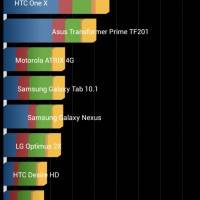



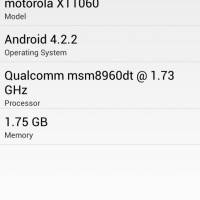



















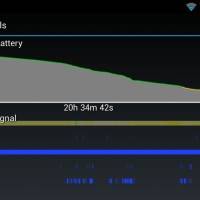

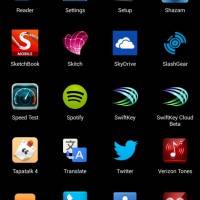














I’m going to whine like a baby again because I just don’t know how you can’t. Why is this phone priced so high again?! I’m not referring to specs are anything, they gave the impression that this phone was going to come a mid price range and I thought it could be that game changer. Sad thing is, I like this phone so much and am ready to upgrade from my Nexus 4 even tho this isn’t a Nexus device but it hurts so much to consider that I’ll have to shelve out over $500 ugh. I suppose I can wait for the announcement of the new Nexus…
Honest to God question, is this camera actually any decent? I’ve been reading mix reviews about the low light feature.
It’s so expensive because Google isn’t footing most of the bill like it does with the Nexus line?
Probably because moto’s leadership was so entrenched in their old ways and enough of them haven’t been fired yet.
I didn’t expect it to compete in price directly against the Nexus program, but I agree with you that it’s priced WAY too high (and involved in too many contract only plans and carrier exclusives) to have any positive effect on the market.
It went from “game changer” to just another bland offering the instant the pricing and availability was announced.
Would you buy it if all carriers had it for $99 instead?
Apparently you can bypass the passcode while driving if your Moto X connects to another device such as a bluetooth headset that it knows is ‘familiar’. This was reported on another site.
I have bought the moto x and I would like to know if you think that I should buy a screen protector and/or a case for my moto x?
Please tell my what you think and why…